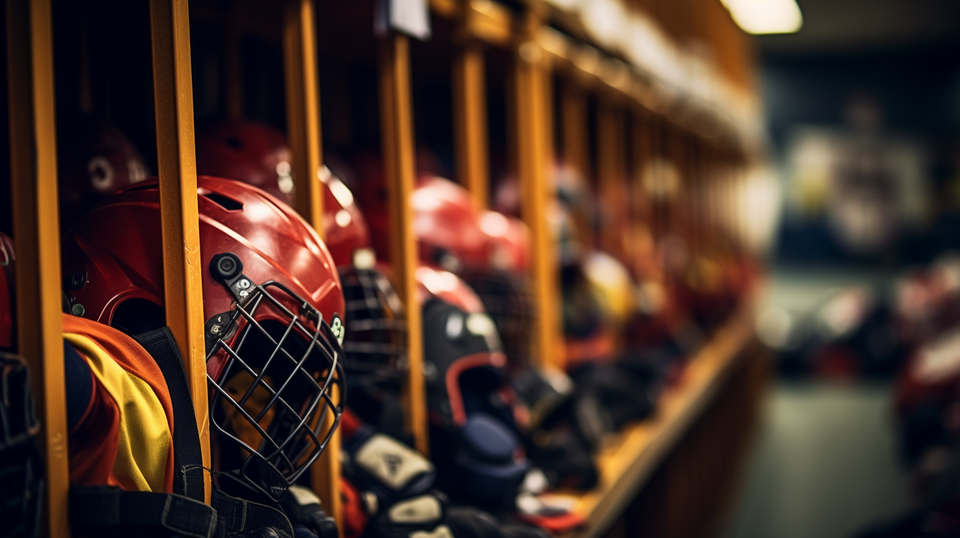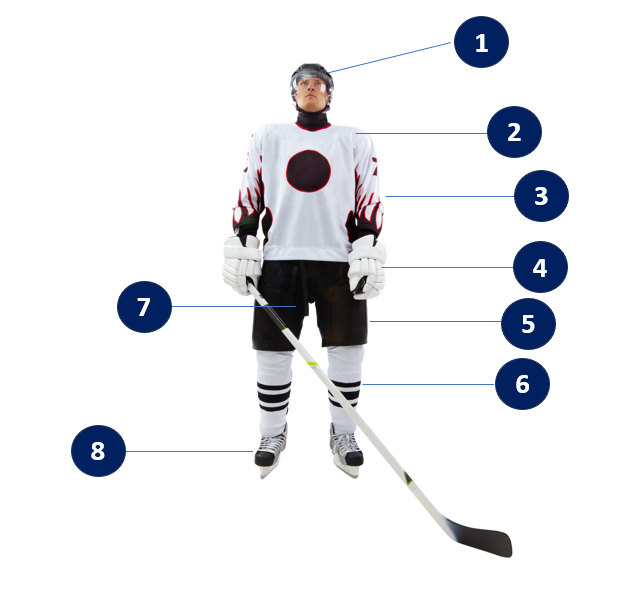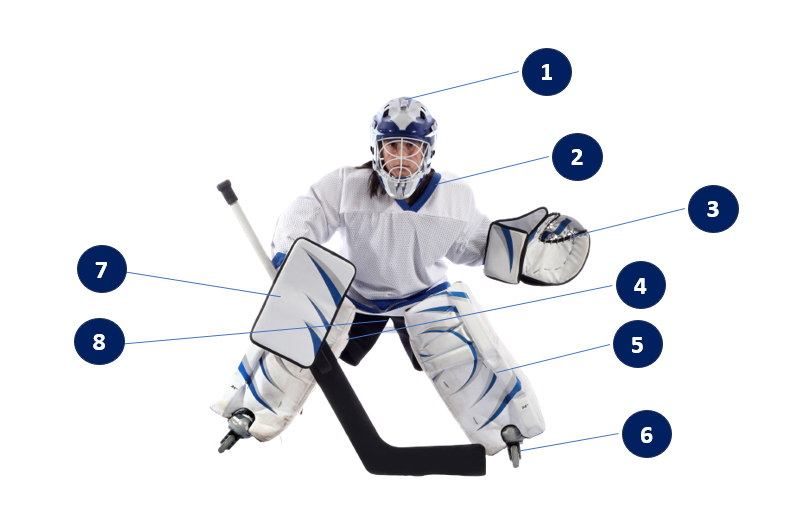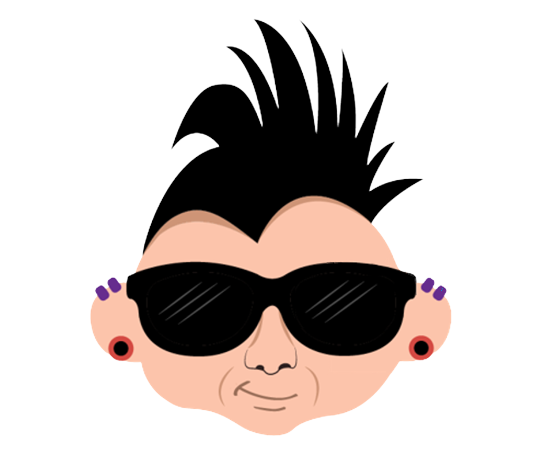Knight's on Ice: The Art and Mystery of Hockey Armor

In this Edition
- What is the Essential Equipment Worn by Players?
- Is there Optional Equipment Players Wear?
- What Equipment does a Goalie Wear?
- What is the Specialized Nature of Goalie Equipment?
- What about the Jerseys?
What is the Essential Equipment Worn by Players?
Ice hockey is a high-energy sport that demands protective equipment to ensure player safety. Let's take a closer look at the essential gear. Below is a diagram of a hockey player with each numbered call-out representing the key protective equipment that a skater wears. It is described below the diagram.

- Helmets: Helmets provide crucial head protection, shielding players from potential head injuries. Modern helmets are designed to absorb impacts and reduce the risk of concussions. Players also wear plastic molded face shields for extra facial protection.
- Shoulder Pads: Shoulder pads offer protection to the upper body, including the shoulders, chest, and spine. They cushion players from hits and absorb impact.
- Elbow Pads: Elbow pads safeguard the elbows from injuries due to falls, collisions, or contact with other players or the boards.
- Gloves: Gloves provide hand and wrist protection while allowing players to grip their sticks effectively. They shield the fingers, knuckles, and palms.
- Pants: Hockey pants provide padding and protection for the hips, thighs, and tailbone. They safeguard players from injuries caused by falls or impacts.
- Shin Guards: Shin guards protect the lower legs, especially the shins and knees, from slashes, pucks, and collisions.
- Jockstrap/Jill: A jockstrap for male players or a jill for female players is essential for protecting the pelvic area.
- Skates: Hockey skates are specially designed to provide support, balance, and maneuverability on the ice. They have sharp blades that allow players to glide and change direction swiftly.
Is there Optional Equipment Players Wear?
There are some additional gear that a hockey player uses for additional protection, which we've listed below.
- Mouthguards: Mouthguards protect players' teeth, gums, and jaws from potential impacts during gameplay.
- Neck Guards: Neck guards are worn to protect the neck and throat area from errant sticks and pucks.
- Socks: Hockey socks are worn over the shin guards to provide a smooth surface for uniformity and branding while also protecting the lower legs. (They also hold the shin guards in place with some hockey tape.)
- Girdles or Compression Shorts: These garments provide additional support and padding for the hips, thighs, and tailbone.
- Practice Jerseys: Practice jerseys, often in different colors from game jerseys, allow teams to differentiate between offensive and defensive players during training sessions.
What Equipment does a Goalie Wear?
A hockey goalie requires specific equipment to protect themselves and effectively perform their role. Below is a picture with numbered call-outs and descriptions of the typical gear worn by a hockey goalie below the picture.

- Mask or Helmet: The goalie wears a specially designed mask or helmet to protect their head and face. It features a cage or visor to shield the face from flying pucks, sticks, and other potential impacts.
- Chest Protector: The chest protector, also known as a goalie "chesty" or "blocker," covers the upper body, including the chest, shoulders, and arms. It consists of a padded body piece and arm pads to absorb and distribute the force of incoming shots.
- Goalie Catcher: The catcher, worn on the dominant hand, resembles a baseball glove and is used to catch or "glove" shots. It has a wide pocket with ample padding to secure the puck and protect the hand and fingers.
- Goalie Pants: These pants are heavily padded to protect the hips, thighs, and groin. They have a wide design that extends down to the knees, providing ample protection for these areas.
- Goalie Pads: The leg pads worn by a goalie are perhaps the most distinctive piece of equipment. They cover the lower legs and knees and are heavily padded to provide protection and help in making saves. The pads are wide and bulky, designed to block shots and cover a significant portion of the net.
- Goaltender Skates: Goaltending skates are slightly different from regular player skates. They have a flatter blade and additional ankle protection to provide stability and support.
- Goalie Blocker: The goalie's blocker is a glove-like piece worn on the non-dominant hand (e.g., left hand for right-handed goalies). It has a large rectangular blocking surface to stop or redirect shots. The blocker also features additional padding to protect the fingers and wrist.
- Jock or Pelvic Protector: A jockstrap or pelvic protector is worn to protect the groin area. It consists of a cup that shields the sensitive areas from potential impacts.
What is the Specialized Nature of Goaltending Equipment?
Goaltenders require specialized gear due to the unique demands of their position. Here are some crucial pieces of goalie-specific equipment and how they differ from a skater's equipment.
- Leg Pads: Leg pads (also called goalie pads) are larger and thicker than those worn by skaters, providing extensive coverage and cushioning to protect the goaltender's legs. (Some shots from players can surpass 100 miles an hour, so having thick and effective goalie pads.)
- Chest Protector: The chest protector shields the torso, including the chest and arms, from pucks and player collisions.
- Blocker and Trapper: The blocker is worn on the stick hand and aids in deflecting shots, while the trapper is worn on the glove hand and helps catch or freeze the puck.
- Mask/Cage: The mask or cage protects the goaltender's face from flying pucks, sticks, and other potential impacts.
- Goalie Skates: Goaltenders wear specialized skates designed for additional stability and protection.
What about the Jerseys?
Player jerseys in hockey serve multiple purposes beyond just team identification. They typically feature a player's name and number on the back and the team logo on the front. Jerseys are not only a means of identification but also serve as a symbol of team pride and unity. NHL teams also have multiple jerseys they wear throughout the season. For example, teams will typically wear a lighter jersey when they're on the road (away) and a darker jersey when they're not (home). They also have "third jerseys" and often have special jerseys that celebrate certain holidays or events.
Now that you're well-versed in the equipment and gear used in ice hockey, you have a deeper understanding of the importance of player safety and performance-enhancing gear. Check out our other posts in the Puck 101 series, where we explore all things hockey!
Subscribe to our newsletter to get the latest and greatest content on all things hockey analytics!

Member discussion